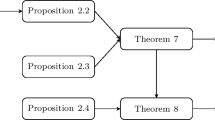Abstract
We show that with high probability the number of real zeroes of a random polynomial is bounded by the number of vertices on its Newton–Hadamard polygon times the cube of the logarithm of the polynomial degree. A similar estimate holds for zeroes lying on any curve in the complex plane, which is the graph of a Lipschitz function in polar coordinates. The proof is based on the classical Turán lemma.
Similar content being viewed by others
References
A. Bloch and G. Pólya, On the roots of certain algebraic equations, Proc. London Math. Soc. 33 (1932), 102–114.
P. Erdős and A. C. Offord, On the number of real roots of a random algebraic equation, Proc. London Math. Soc. (3) 6 (1956), 139–160.
I. A. Ibragimov and N. B. Maslova, The mean number of real zeros of random polynomials. I. Coefficients with zero mean (Russian), Teor. Verojatnost. i Primenen. 16 (1971), 229–248; English transl.: Theor. Probability Appl. 16 (1971), 228–248; II. Coefficients with a nonzero mean, ibid, 495–503; English transl.: 485–493.
I. A. Ibragimov and N. B. Maslova, The average number of real roots of random polynomials (Russian), Dokl. Akad. Nauk SSSR 199 (1971), 13–16; English transl.: Soviet Math. Dokl. 12 (1971), 1004–1008.
I. Ibragimov and Dm. Zaporozhets, On distribution of zeros of random polynomials in complex plane, in Prokhorov and Contemporary Probability Theory, Springer Proc. Math. Stat., 33, Springer, Heidelberg, 2013, pp. 303–323.
M. Kac, On the average number of real roots of a random algebraic equation, Bull. Amer. Math. Soc. 49 (1943), 314–320; A correction, ibid, 938.
A. N. Kolmogorov, de M. P. Lévy, Ann. Inst. H. Poincaré 16 (1958), 27–34.
J. E. Littlewood and A. C. Offord, On the number of real roots of a random algebraic equation, I, Journal London Math. Soc. 13 (1938), 288–295; II, Proc. Cambridge Phil Soc. 35 (1939), 133–148; III, Rec. Math. [Mat. Sbornik] N.S. 12(54) (1943). 277–286.
B. F. Logan and L. A. Shepp, Real zeros of random polynomials, I, Proc. London Math. Soc. 18 (3) (1968), 29–35;II, ibid, 308–314.
H. L. Montgomery, Ten Lectures on the Interface Between Analytic Number Theory and Harmonic Analysis, Amer. Math. Soc., Providence, RI, 1994.
F. Nazarov, Local estimates for exponential polynomials and their applications to inequalities of the uncertainty principle type (Russian), Algebra & Analiz 5 (1993), no. 4, 3–66; Theory Probab. Appl. 55 (2011), 173–181.
G. Pólya and G. Szegő, Problems and Theorems in Analysis II,Reprint of the 1976 English translation, Classics in Mathematics, Springer-Verlag, Berlin, 1998.
L. Shepp and K. Farahmand, Expected number of real zeros of a random polynomial with independent identically distributed symmetric long-tailed coefficients, Teor. Veroyatn. Primen. 55 (2010), 196–204; Theory Probab. Appl. 55 (2011), 173–181
K. Söze, Real zeroes of random polynomials, II.Descartes’ rule of signs and anticoncentration on the symmetric group, Israel Journal of Mathematics, this volume.
D. N. Zaporozhets, An example of a random polynomial with unusual behavior of the roots (Russian), Teor. Veroyatn. Primen. 50 (2005), 549–555; English transl.: Theory Probab. Appl. 50 (2006), 529–535.
Author information
Authors and Affiliations
Corresponding author
Additional information
To Ildar Ibragimov with admiration
Rights and permissions
About this article
Cite this article
Söze, K. Real zeroes of random polynomials, I. Flip-invariance, Turán’s lemma, and the Newton-Hadamard polygon. Isr. J. Math. 220, 817–836 (2017). https://doi.org/10.1007/s11856-017-1535-6
Received:
Revised:
Published:
Issue Date:
DOI: https://doi.org/10.1007/s11856-017-1535-6



